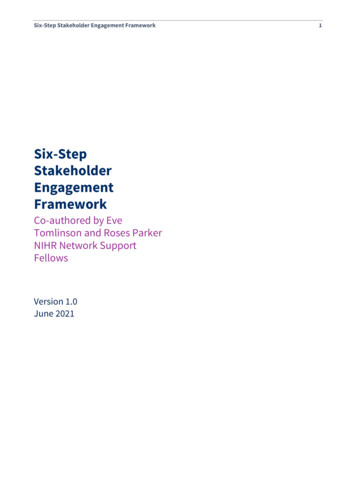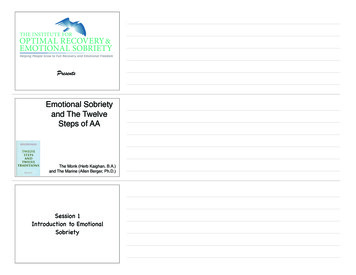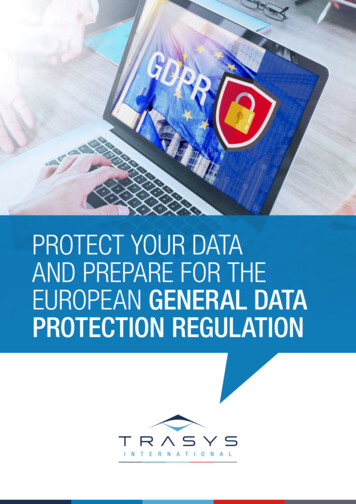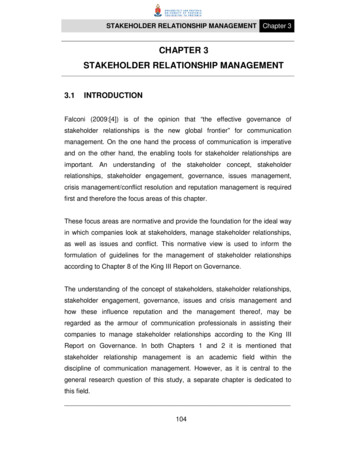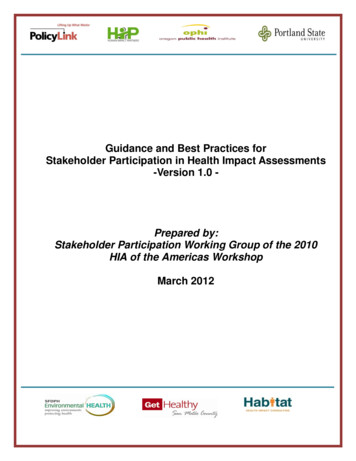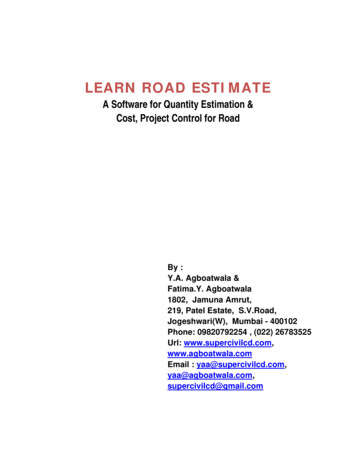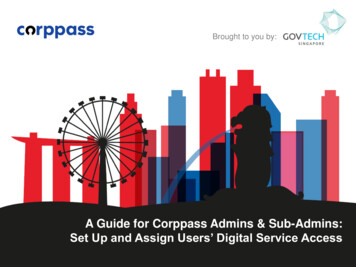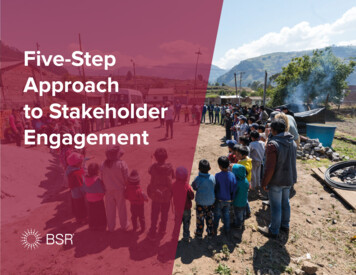
Transcription
Five-StepApproachto StakeholderEngagement
Five-Step Approachto Stakeholder EngagementABOUT THIS REPORTThis report was originally written by Jonathan Morris and Farid Baddache in2011. The new edition was written by Alison Taylor and Charlotte Bancilhon in2019, with support and input from Cecile Oger. It has been revised to account fornew developments in sustainability and human rights that are driving the needfor fresh tools and approaches.The report is based on our long experience working on stakeholderengagement with companies, a literature review, and interviews with membercompanies and BSR employees. Any errors are those of the authors. Pleasedirect comments or questions to Alison Taylor at ataylor@bsr.org.DISCLAIMERBSR publishes occasional papers as contributions to the understanding of therole of business in society and trends relating to corporate social responsibilityand responsible business practices. BSR maintains a policy of not acting asa representative of its membership; nor does it endorse specific policies orstandards. The views expressed in this publication are those of its authors anddo not reflect those of BSR members.
ContentsIntroduction 4STEP 1Stakeholder EngagementStrategy 8BSR’s Five-Step Approach9There Is a Step Zero10Making the Business Case:The Value of Stakeholder Trust11Building a Strategic Vision13STEP 2Stakeholder Mapping 16STEPS 3 & 4Preparation and Engagement27What Is Stakeholder Mapping?17Core Engagement Principles28A Note on Influence21Getting Started29Have You Developed the ‘Right’ List? 26Knowing the Other32The Raw Logistics32The Engagement33STEP 5Action Plan 34A Dual Action Plan35Send It Out and Follow Up36Considerations for Ongoing Engagement36Closing the Feedback Loop37
Introduction
BSR’s Five-Step ApproachSTEP5STEPFeedback LoopACTION PLANSTEP4ENGAGEMENTIdentify opportunities fromfeedback and determineactions, revisit goals, andplan next steps for follow-upand future engagementConduct theengagement itself,ensuring equitablestakeholdercontributions andmitigating tensionwhile remainingfocused on priorities1ENGAGEMENTSTRATEGYSet vision and levelof ambition for futureengagement, and reviewpast engagementsFIVE-STEPAPPROACH TOSTAKEHOLDERENGAGEMENTFocus on long-term goals todrive the approach, determinelogistics for the engagement,and set the rulesDefine criteriafor identifyingand prioritizingstakeholders, andselect engagementmechanismsSTEP2STAKEHOLDERMAPPINGWe have updatedBSR’s five-step guide toSTEP3PREPARATIONstakeholder engagementto reflect the even higherstakes at play in 2019.5 Five-Step Approach to Stakeholder Engagement
Stakeholder engagement is—and will remain—acore element of the sustainability toolkit. It is afundamental component of materiality assessments,which are then used to inform sustainabilitystrategy, reporting, and disclosure. Corporationsneed strategies in order to understand and respondto existing and emerging societal concerns. Withoutinput from key stakeholder groups, any approachto sustainability will be limited by an organization’sself-interest and inward focus.primarily as a public relations or communicationsexercise. They struggle to relate the engagementto their core business activities and find it difficult tobuild internal awareness and interest in the process.When the time comes to map stakeholders, theytalk only to those they already know or to thosewho speak loudest. Even if they succeed ingathering useful insights from stakeholders, theyhave difficulty determining what actions to take inresponse.Stakeholder engagement has never come withhigher stakes or been more important. Companiesneed a robust, defensible methodology andtools that can account fully for a shifting businessenvironment in which social and environmentalconcerns are increasingly prominent. We havereviewed and revised our original frameworks toaccount for the rising expectations and wideningtrust deficit we see affecting relationships betweenmany companies and their stakeholders.These fundamental challenges have becomeconsiderably more pressing since 2011. Exponentialgrowth in internet access and connectivity hasshifted the terms and avenues for stakeholderengagement. It has spurred the developmentof powerful social networks in which unfilteredupdates on global events can be shared amongmillions of users in real time, undercutting anddiluting the influence of traditional news media.In this environment, disputes about a company’soperations can be adopted and amplified byinternational civil society organizations and evenby individuals, heightening their visibility andimpact. This can afflict companies with whiplashas they try to anticipate and respond to waves ofcriticism. At the same time, companies are beingdrawn into taking positions on sensitive politicaland social issues, from immigration to climateAlthough engaging with stakeholders is essential, itis far from easy: As companies perceive increasingreputational pressure, they recognize that they mustact, but often sign on to an engagement methodwithout understanding it or clarifying their intent.Many mistakenly view stakeholder engagement6Five-Step Approach to Stakeholder EngagementMany mistakenlyview stakeholderengagement primarilyas a public relationsor communicationsexercise.
change, that would previously have been left topublic policymakers. We have therefore shifted theemphasis of our BSR framework toward buildingmutual trust, including the introduction of corestakeholder engagement principles.The investor communityhas become significantlymore focused on theneed for companies toconsider environmental,social, and governanceissues if they intend tosurvive and thrive overthe longer term.7 Five-Step Approach to Stakeholder EngagementOver the same period, we have seen theestablishment and maturation of internationallyaccepted sustainability frameworks: TheParis Agreement on Climate, The SustainableDevelopment Goals, and the UN Guiding Principleson Business and Human Rights are a few examples.These have made sustainable business efforts moreconsistent and coherent by codifying the goalsand intent of sustainability efforts. The frameworksare driving a shift from exclusive consideration ofcorporate risk to an understanding of corporateimpacts on society. We have therefore incorporatedcriteria regarding impact and vulnerability in ournew framework.Finally, the investor community has becomesignificantly more focused on the need forcompanies to consider environmental, social,and governance issues if they intend to surviveand thrive over the longer term. This, in turn,necessitates a strategic shift from an exclusivefocus on shareholder value to serving broaderstakeholder interests. In 2018, Larry Fink, chiefexecutive officer of BlackRock Inc., the world’slargest investment firm, made the bold declarationthat “to prosper over time, every company must notonly deliver financial performance, but also showhow it makes a positive contribution to society.” Thisdirect riposte to Milton Friedman’s 1970 argumentthat “the social responsibility of business is toincrease its profits” came as a key turning pointin mainstream investor thinking on sustainabilityissues.In 2011, when we first published this five-stepguide to stakeholder engagement, our membercompanies were asking for guidance on effectiveimplementation of this key element in the corporatesustainability toolkit. In 2016, we wrote a new report,“The Future of Stakeholder Engagement,” whichcalled for an overhaul of stakeholder engagementto account for developments in the sustainabilityand human rights fields. In 2019, corporations facean even clearer need to focus on stakeholder trustin the context of accelerating transparency. Thisreport aims to provide a comprehensive toolkit thatincorporates the latest thinking while maintainingthe clarity and practicality of our five-step approach.It is designed to provide useful guidance, whetheryour engagement approach is to stage a oneoff roundtable with a few stakeholders or toembrace a comprehensive strategy involving manystakeholders and a variety of engagement tactics.Use this document as a starting point whenapproaching stakeholder engagement for the firsttime, or as a refresher when revising an existingengagement strategy.
STEP EGYFIVE-STEPAPPROACH TOSTAKEHOLDERENGAGEMENT
STEP1ENGAGEMENTSTRATEGYBSR’s Five-StepApproachBSR has developed a five-stepapproach to show how corporationscan initiate and sustain constructiverelationships over time, throughout theorganization, creating shared value byengaging early and often—and actingbased upon what they hear.9 Five-Step Approach to Stakeholder EngagementSTEP 1ENGAGEMENT STRATEGYBSR’s Five-Step ApproachSet vision and level of ambition for futureengagement, and review past engagementsSTEP 2STEPSTEP5STAKEHOLDER MAPPING1ENGAGEMENTSTRATEGYk LoopACTION PLANSTEPDefine criteria for identifying and prioritizingstakeholders, and select engagementmechanismsSTEP 3PREPARATIONFeedbacWe are in the midst of an increasinglyhigh-stakes debate about the futureof the corporation and its nascentshift in focus from shareholder valueto stakeholder trust, from risk toimpact, and from unrestrained financialgrowth to sustainable business.For companies, this necessitates astrategic and structured approach tostakeholder relations.Focus on long-term goals to drive theapproach, determine logistics for theengagement, and set the rulesFIVE-STEPAPPROACH GENGAGEMENTSTEP3PREPARATION4ENGAGEMENTConduct the engagement itself, ensuringequitable stakeholder contributions andmitigating tension while remaining focused onprioritiesSTEP 5ACTION PLANIdentify opportunities from feedback, anddetermine actions, revisit goals, and plan nextsteps for follow-up and future engagement
STEP1ENGAGEMENTSTRATEGYThere Is a Step ZeroBefore developing an engagement strategy, youmust first understand what stakeholder engagementmeans to your company, as well as your goalsand level of ambition for this exercise. Althoughoften used as a byword for public relations orreputation management, stakeholder engagementis something else. It requires a shift in corporatemindset and a change from treating stakeholders’concerns as external risks that need to be managedto considering them serious topics that merittransparent dialogue—and a strategic response.Stakeholders that choose to engage withcompanies generally expect this interaction togenerate change, which is why it is a mistake totreat engagement as a one-way informationdissemination process, rather than as a dialogue.There may not be widespread understanding of thiswithin your company, which may need to developinternal capacity and buy-in before launchingengagement activities. The organization shouldcomprehend the business case for stakeholderengagement before committing to a resourceintensive exercise.10Five-Step Approach to Stakeholder EngagementIN PRACTICEReach out internally and build a baselineunderstanding around stakeholderengagement—including the business case.This can help avoid the risk of beingunprepared to listen to stakeholderinsight or guidance, as well as that ofunintended “greenwashing.” It also helpsidentify internal champions and ownersof future engagement activities. Theseindividuals and functions are your internalstakeholders; collaborate with them as youbuild your overall strategy.Who Is a Stakeholder?A stakeholder is someone who affects oris affected by your company’s productsor activities. A stakeholder can be eitherwithin or outside your organization. Keystakeholder groups include employees,customers, suppliers, investors, nonprofitpartners, and the communities impactedby your operations.
STEP1ENGAGEMENTSTRATEGYMAKING THE BUSINESS CASE:The Value of Stakeholder TrustFor example:Engagement done well is like asavings fund: The value adds upover time and acts as a cushionin times of reputational or fiscaldistress. Companies that are moreaware of stakeholder interests aremore likely to avoid crises becausethey are better able to anticipaterisks and opportunities. A number ofcompelling studies on the impactsof good community and stakeholderrelations across industries andcountries have concluded thatcompanies that intentionally buildstakeholder trust are more financiallyresilient over time, across multipleindicators of value.By now, there is enough evidence toresolve any outstanding doubts as towhether stakeholder engagement isan inherently valuable exercise.11Five-Step Approach to Stakeholder EngagementFINANCIAL RESILIENCEThe value of many years of good stakeholderrelations is often proven during times of crisis. Astudy of U.S. companies found that those with goodstakeholder relations prior to entering a cycle of badfinancial performance tended to recover more readily and wenton to sustain superior financial performance over the long termthan companies with poor stakeholder relations.1RETURN ON EQUITYBetter stakeholder relationships help companiesdevelop such assets as customer or supplierloyalty, reduced employee turnover, and animproved reputation, all sources of competitiveadvantage and corporate value.3 A global study found thatorganizations that make corporate citizenship decisions at theboard level are more likely to consider the interests of multiplestakeholders, resulting in better engagement with customers,employees, and external stakeholders. This also brought thosecompanies a higher overall return on equity than was achievedby peers with a less-integrated approach.4 A detailed study ofstakeholder engagement across 26 publicly owned gold minesclearly demonstrated that a sustained focus on increasingstakeholder support enhanced the financial valuation of themining companies.5VALUATIONStakeholder perceptionhas significant effectson corporate valuation.Analysis by McKinsey& Co. determined that 30 percent ofcorporate earnings are affected by thecompany’s reputation with externalstakeholders.230%REDUCTION IN COSTSPoor stakeholderengagement can lead to avariety of direct and indirectcosts to the company. For example,a study of extractives companiesidentified 33 potential costs associatedwith preventing, responding to, ormanaging the outcomes of conflictswith local communities. The mostfrequent costs were linked to lostproductivity from project delays orshutdowns, running in the tens ofmillions of dollars per week.6
Stakeholder engagement needs anoverhaul. The practice emerged tohelp companies build greater trust withsocietal groups that might affect thedelivery and success of their businessstrategy in a material way.There is now broad consensus thatall companies should engage theirstakeholders. However, in mostorganizations, implementationremains a limited reputationalrisk exercise that is perceived asproviding few benefits.Excerpt from BSR’s “Future of Stakeholder Engagement”12Five-Step Approach to Stakeholder Engagement
STEP1ENGAGEMENTSTRATEGYBuilding a Strategic VisionWith internal alignment and a commonunderstanding of the purpose of stakeholderengagement, you can move on to shape yourstrategic vision. The following steps allow you to:1.11.2HISTORY OF ENGAGEMENTSET A STRATEGIC VISION:WHY ENGAGE?The first step is to look at your company’s history.Lessons learned from past efforts will inform thecurrent strategy.IN PRACTICE Focus on where stakeholder engagementcan have the biggest impact on your strategyand operations Define and lead cost-effective and impactfulstakeholder engagement activities Learn from past experiences to assess yourgoals and clarify objectives Clarify the business case for engagement Understand and manage stakeholderexpectationsLook at your previous engagements andanswer the following questions:WHAT: Were our previous attemptssuccessful? Did they fulfill our objectives?What performance indicators support thisassessment? What mistakes did we makeduring our past engagements? What did wemiss?HOW: Were the formats appropriate? Didthey address stakeholders’ concerns?Are there ways we can achieve the sameobjectives by using resources moreeffectively? What would we do differently?WHO: What did we learn about stakeholderexpectations? Did we address them? Havewe provided feedback to our stakeholders?Is the feedback in an appropriate form?Which internal stakeholders need to bemore involved? How?WHY: What were the drivers forengagement? Was there a specific context?How might these have evolved over time?13Five-Step Approach to Stakeholder EngagementThe second step is to understand the motivationbehind engagement. Setting a vision will clarifythe specific objectives you are trying to achieve inbusiness and sustainability.Since 2011, we have seen corporations increasinglystruggle to respond to the urgency and scale ofchange in the external environment. For systemicissues such as climate change, inequality, corruption,and discrimination, the purpose of stakeholderengagement must broaden its focus on riskmanagement and reputation-building to includepartnership and collaboration. More recently, theemergence of regulation in various parts of the world,such as the U.K.’s Corporate Governance Code,displays an increasing expectation by governmentsthat companies will consider and integrate theperspectives of stakeholders.Companies will benefit from the structuredincorporation of stakeholder perspectives into themanagement of such strategic challenges as politicalrisk, emerging competitors, and the cumulativeimpact of foreign direct investment in a new region.Even when it comes to gathering stakeholder insightsfor a materiality assessment, companies are oftenfinding that their most material issues cannot beaddressed unilaterally, via direct action, but mustrely on partnerships, collaboration, and efforts toinfluence policy.
STEP1ENGAGEMENTSTRATEGYAll of this suggests the need for a more ambitiousapproach to stakeholder engagement. Whilethere is still a place for reactive efforts to monitoremerging conversations or respond to critiques,we believe that further effort is best applied toproactive, ambitious efforts that can result incollaboration and concrete change.IN PRACTICEAnswer the following questions tounderstand your objectives:PRIORITY: What is our priority in engagingstakeholders at this phase? Reacting toexternal pressures? Developing strategicinsights? Protecting our reputation? Seekinginnovation and building new products andservices? Building relationships in newmarkets? Mitigating systemic risk?SCOPE: What is the scope? Let’s considerissues and geography to set boundaries.Given increasing transparency, we shouldconsider both global and local exposure—and the interaction between them.WHERE does engagement fit in ourorganization? Who should be owners(CEO, corporate affairs, business units,etc.)? What is their level of willingness andunderstanding?14Five-Step Approach to Stakeholder Engagement1.3WHO HAS A STAKE?Your strategy should carefully define the boundariesof your stakeholder landscape. In a broad corporatestakeholder engagement process that envisageslonger-term relationships, a full stakeholdermapping may be required; Step 2 will addressthis below. However, more specific, time-boundengagements may not require a full engagementprocess because relevant stakeholder groupsare already apparent. For example, communityengagement exercises need local civil societygroups and citizens. A mix of mainstream andsocially responsible investors may be well-placedto give feedback on your new reporting approach.Academics and digital rights experts may be bestplaced to help you navigate how to handle hatespeech on your digital platform.
STEP1ENGAGEMENTSTRATEGY1.4HOW TO ENGAGEFinally, how you engage will be considered in moredetail in later steps, but it is directly informed byyour overall vision and level of ambition, whetherthe engagement is proactive or reactive, and by theresources available. Most important, you need todetermine whether this is to be a one-off event orthe start of an ongoing, iterative process.Engagement could take the form of a singlemeeting or involve the creation of a continuingdialogue mechanism such as a stakeholder advisoryboard. While both approaches have value, they areresponses to different needs.Are You Ready toMove On?Check that you have reviewed yourengagement history, decided ona level of ambition, and clarifiedbusiness objectives for theengagement. If so, you can move on.Top Three DOsand DON’TsDOLink engagement strategy tobusiness strategy.Focus internally beforeexternally (gain buy-in, findchampions).Learn from past experience,both successes and failures.DON’TIN PRACTICEConsider the impetus for this engagementprocess.If you are mounting a strategic initiativeand looking to fundamentally changeyour business model, you might considerdeveloping an ongoing, comprehensiveengagement approach. If an outside eventhas triggered the engagement, a singlemeeting may be suitable.15Five-Step Approach to Stakeholder EngagementDecide on stakeholdersbefore deciding on yourobjectives.Jump directly to choosingan engagement format.Ignore internal concerns.
STEP PAPPROACH TOSTAKEHOLDERENGAGEMENTSTEP2STAKEHOLDERMAPPING
STEP2STAKEHOLDERMAPPINGMapping is an important step to understandingwho your key stakeholders are, where theycome from, and what their relationship is to yourbusiness. To be effective, this process shouldbe informed by your overall strategic vision, asdiscussed above.Mapping can be conducted to varyinglevels of depth. Companies often undertakecomprehensive mapping exercises of their entirestakeholder landscape, and then map the resultsto an engagement approach. Alternatively, fora one-off stakeholder event, the mapping canidentify who should attend, given the goals andlevel of ambition of the exercise.What Is Stakeholder Mapping?Stakeholder mapping is a collaborative process of research, analysis, debate, and discussion thatdraws from multiple perspectives to determine a key list of stakeholders across the entire stakeholderspectrum. Mapping can be broken down into four phases:Four Phases of Stakeholder MappingIDENTIFYSTAKEHOLDERS:List relevant groups,organizations, andpeople, and identifytheir focus areas.ANALYZE:MAP:Analyze andrank stakeholderrelevanceVisualize relationshipsto objectives and toother stakeholders.The process of stakeholdermapping is no less important thanthe result. It depends heavily onthe approaches and attitudes ofthe people participating.SELECTENGAGEMENTAPPROACHES:Assign specificapproaches to yourstakeholders.IN PRACTICEGather a cross-functional group of internal participantsto engage in this process. Identify sources external tothe company who may have important perspectiveson the issues, and consult these sources for input andparticipation. Finally, identify an individual (internalor external) who can facilitate your work through thefollowing activities. Capture all your work in writing tohelp with future steps.17Five-Step Approach to Stakeholder Engagement
STEP2STAKEHOLDERMAPPING2.1IDENTIFY STAKEHOLDERSThe first step in the mapping process is tounderstand that there is no magic list ofstakeholders. The final list will depend on yourbusiness, its impacts, and your strategic vision.It should not remain static over time, but shouldchange as the external environment evolves andas stakeholders themselves make decisions,shift focus, or change their opinions.18Five-Step Approach to Stakeholder EngagementIN PRACTICEBrainstorm a list of stakeholders without screening; include everyone who has an interest in yourobjectives today and who may have one tomorrow. Where possible, identify individuals—not justorganizations. Identify the issues covered by the agenda and focus of each stakeholder.Use the following list to help you brainstorm: Owners(e.g., investors, shareholders, agents, analysts, and ratings agencies) Customers(e.g., direct customers, indirect customers, and advocates) Employees(e.g., current employees, potential employees, suppliers’ employees, retirees, representatives,and dependents) Industry(e.g., suppliers, competitors, industry associations, industry opinion leaders, and media) Community(e.g., residents near company facilities, chambers of commerce, resident associations, schools,community organizations, and special interest groups) Environment(e.g., nature, non-human species, future generations, scientists, ecologists, spiritualcommunities, advocates, and nongovernmental organizations, or NGOs) Government(e.g., public authorities and local policymakers, regulators, and opinion leaders) Civil society organizations(e.g., NGOs, faith-based organizations, labor unions, and general public)
STEP2STAKEHOLDERMAPPINGHere are some additional considerations to help2.2ANALYZEyou brainstorm:Learn from past and current engagements:Look at your organization’s previous and ongoingengagement activities. What were and are theobjectives of these activities? Which stakeholderscommunicate regularly with your company? Whatstakeholder category (or categories) are they in? Isthere an opportunity (or a pressing need) to reachbeyond your comfort zone to engage with lesserknown stakeholders?Use technology tools—and judgment: Analyzingyour social and online media profile providesunparalleled opportunities to understand who iscurrently talking about your business and the issuesyou are aiming to tackle. On key issues, there isoften a big gap between sentiment in traditionalonline media and in social media. Looking closelyat these trends can help you understand andanticipate shifts in public opinion.Consider the future: Assess potential stakeholdersfrom new markets, new technologies, newcustomers, and new interest groups. Depending onyour objectives, the relevant stakeholders you needto engage with may not be the “usual suspects”of sustainability; prominent NGOs and responsibleinvestors.Consider your impact: Still, it is crucial not toprioritize noisy critics over genuine experts. If youfocus only on reacting to the loudest voices, youwill soon end up with whiplash. It is also importantto consider the impacts of your business onstakeholders—not just the risk to your businessfrom stakeholders. Step back and consider who ismost impacted by your operations and decisions.This will incorporate the latest thinking on how todrive a meaningful dialogue.Ensure diversity: Make sure to include a richdiversity of stakeholders embodying a spectrumof expertise, attitudes, and geographies. This is anopportunity to reach out and mix the old with thenew, including individuals from each of the followingstakeholder categories: influencers, collaborators,advocators, critics, and implementation partners.19Five-Step Approach to Stakeholder EngagementOnce you have defined your landscape ofstakeholders, analysis will help you map andunderstand that landscape. BSR has developed alist of potential criteria you might use to analyzestakeholder organizations, groups, or individuals.Not all of these criteria will be relevant for everyengagement, and we recommend an absolutemaximum of four distinct criteria:Influence: How much influence does thestakeholder have over your company or project,either directly or via other stakeholders? (You willneed to clarify “whom” they influence—for example,other companies, NGOs, consumers, investors.)Expertise: Does the stakeholder have information,counsel, or expertise on the issue that could behelpful to the company, either directly or becausethey will shape the future of an issue (for example, arecognized expert on circular-economy issues)?Orientation: Is the view of the stakeholder towardthe company/engagement/issue a collaborative orcombative one? How willing is the stakeholder toengage with the company and the overall process?
STEP2STAKEHOLDERMAPPINGPrioritizing: rankingIN PRACTICEstakeholderrelevance andidentifying issuesSelect from among these criteria to create and populate a chart with short descriptions of howstakeholders fulfill them. Assign values (low, medium, or high) to these stakeholders. This first dataset will help you later decide which stakeholders to engage—and how. Here is an example:Vulnerability: To what degree will thestakeholder be impacted by the project,company, or initiative? Is the stakeholder amember of a vulnerable social identity group (forexample, children, indigenous peoples), and isthere a related human rights impact?StakeholderCapacity: To what degree does the stakeholderhave the capacity to engage at the leveldesired by the company? To what degree isthe stakeholder able to meet the commitmentsrequired for the entire ityCapacityTrustHigh:Stakeholder isa key shaper ofopinion in thisfieldHigh:Knowledge inthe issue is ofvalue to thecompanyHigh: Proactivegroup that ishighly engagedwith businessHigh: Thecompany/project willdirectly impactthe lives of thisgroupLow: Thegroup has fewresources forengagementLow: Mutualtrust is iumLowHighHighLowATrust: What degree of mutual familiarity andtrust is there between the company and thestakeholder? Is there a track record of bothsides adhering to commitments, respectingconfidentiality, and engaging in productivedialogue?What analytical criteria are relevant? Review your engagement strategy before you select criteria. Expertise, influence, and orientation are likely to be relevant for any strategic engagement with key stakeholder groups,such as a materiality assessment. Vulnerability and orientation are essential to a project or initiative with any potential for negative human rights impacts,and stakeholders with the highest vulnerability and negative orientation are likely to be a priority for engagement. In corporate social-activism efforts, influence, trust, and orientation will help the company anticipa
BSR's Five-Step Approach BSR has developed a five-step approach to show how corporations can initiate and sustain constructive relationships over time, throughout the organization, creating shared value by engaging early and often—and acting based upon what they hear. STEP 1 ENGAGEMENT STRATEGY 9 Five-Step Approach to Stakeholder Engagement
